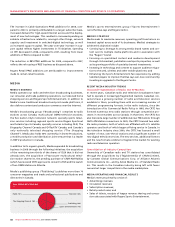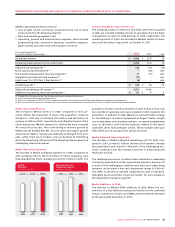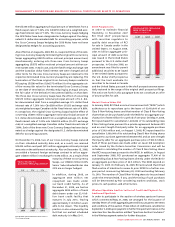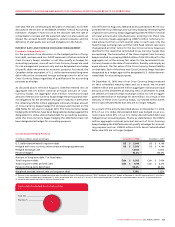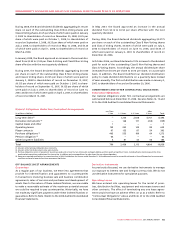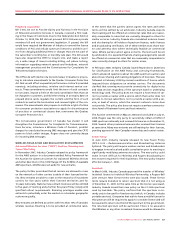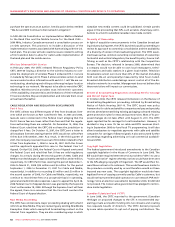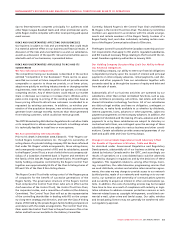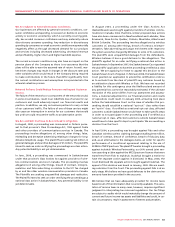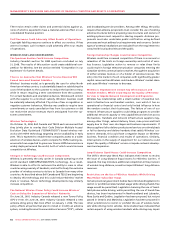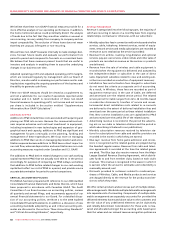Rogers 2008 Annual Report Download - page 62
Download and view the complete annual report
Please find page 62 of the 2008 Rogers annual report below. You can navigate through the pages in the report by either clicking on the pages listed below, or by using the keyword search tool below to find specific information within the annual report.
58 ROGERS COMMUNICATIONS INC. 2008 ANNUAL REPORT
MANAGEMENT’S DISCUSSION AND ANALYSIS OF FINANCIAL CONDITION AND RESULTS OF OPERATIONS
purchase the spectrum at an auction. See discussion below entitled
“We Are and Will Continue to Be Involved in Litigation”.
In SAB-002-06 Consultation on Implementation Matters Related
to the Band Plan and the Mobile Service for the Band 2500 –
2690 MHz, Industry Canada announced a consultation process on
2.5 GHz spectrum. This process is to include a discussion of the
implementation matters associated with harmonizing with the U.S.
band plan. The process will also examine issues related to setting
a firm transition date to allow for nation-wide implementation of
the band plan and the mobile service.
Wireless Enhanced E911 Service
In February 2009, the CRTC released Telecom Regulatory Policy
CRTC 2009-40 issuing a directive to the wireless industry to com-
plete the deployment of wireless Phase II enhanced E9-1-1 service
in Canada by February 2010. Phase II allows wireless carriers to send
more accurate location information with each 9-1-1 call. We are cur-
rently testing, developing and rolling out the required geo-location
technology in our network. We expect to be able to meet the CRTC
deadline. Wireless service providers must inform their customers
of the availability, characteristics and limitations of their enhanced
911 services before they are implemented, and reiterate them on an
annual basis thereafter.
CABLE REGUL ATION AND REGUL ATORY DEVELOPMENTS
Part II Fees
The CRTC collects two different types of fees from broadcast licen-
cees which are known as Part I and Part II fees. In 2003 and 2004,
lawsuits were commenced in the Federal Court alleging that the
Part II licence fees are taxes rather than fees and that the regula-
tions authorizing them are unlawful. On December 14, 2006, the
Federal Court ruled that the CRTC did not have the jurisdiction to
charge Part II fees. On October 15, 2007, the CRTC sent a letter to
all broadcast licencees stating that the CRTC would not collect Part
II fees due in November, 2007. As a result, in the third quarter of
2007, the Company reversed its accrual of $18 million related to Part
II fees from September 1, 2006 to June 30, 2007. Both the Crown
and the applicants appealed this case to the Federal Court of
Appeal. On April 28, 2008, the Federal Court of Appeal overturned
the Federal Court and ruled that Part II fees are valid regulatory
charges. As a result, during the second quarter of 2008, Cable and
Media recorded charges of approximately $30 million and $7 million,
respectively, for CRTC Part II fees covering the period September 1,
2006 to March 31, 2008 ($25 million and $6 million for the period
September 1, 2006 to December 31, 2007 for Cable and Media,
respectively). In addition to recording $5 million and $2 million in
the second quarter of 2008, for Cable and Media, respectively, we
continue to record these fees on a prospective basis in operating,
general and administrative expenses. Leave to appeal the April 28,
2008 Federal Court of Appeal decision was granted by the Supreme
Court on December 18, 2008. Although the Supreme Court will hear
the appeal, there is no assurance that the Court will overturn the
Federal Court of Appeal decision.
New Media Proceeding
The CRTC has commenced a major proceeding dealing with what it
refers to as New Media. They are reviewing any existing New Media
Exemption Order which exempts all broadcasting content on the
Internet from regulation. They are also considering ways in which
Canadian new media content could be subsidized. Certain parties
argue in the proceeding that ISPs, such as Cable, should pay contri-
butions to a fund to subsidize Canadian new media content.
Diversity of Ownership
In light of acquisition announcements in the Canadian broadcast-
ing industry during 2007, the CRTC launched a public proceeding to
review its approach to ownership consolidation and the availability
of a diversity of voices in the broadcasting system. The CRTC exam-
ined issues such as common ownership; concentration of ownership;
horizontal and vertical integration; the benefits policy; licence traf-
ficking; as well as the CRTC’s relationship with the Competition
Bureau. The decision, released in January 2008, determined that
a company would not be able to own local newspapers, televi-
sion stations and radio stations in a given local market. Television
broadcasters cannot own more than 45% of the market (including
both over-the-air and specialty) measured by total hours tuned.
Broadcast distribution undertakings cannot control all of the dis-
tribution networks in a market. Management does not believe that
these restrictions will impact our current plans.
Review of Broadcasting Regulations including Fee -for-Carriage
and Distant Signal Fees
In October 2008, the CRTC released its Decision on the Review of
Broadcasting Regulations proceeding initiated by Broadcasting
Notice of Public Hearing 2007-10. The CRTC issued new policy
frameworks for cable and satellite companies and pay and specialty
services aimed at streamlining existing packaging rules and relaxing
genre protection rules for news and sports services. Most of its pro-
posed changes do not take effect until August 31, 2011. The CRTC
again rejected fee-for-carriage for local broadcasters. However, it
decided to levy a new 1% tax on cable and DTH revenues (start-
ing in September 2009) to fund local TV programming. It will also
allow broadcasters to negotiate payments with cable and satellite
companies for carriage of distant signals. It also announced further
proceedings regarding advertising on local commercial availabili-
ties and VOD.
Copyright Legislation
The federal government introduced amendments to the Canadian
copyright legislation in the House of Commons in June 2008. The
Bill would have required Internet service providers (“ISPs”) to use a
“notice and notice” regime whereby notices would have been sent
to the ISPs alleging copyright infringement. The ISP would then for-
ward these notices to its customers. This would have been similar to
the procedure currently used by us and therefore would not have
imposed any new costs. The copyright legislation would also have
legalized forms of copying currently used by Cable’s customers, but
would not have permited cable operators to use network PVR tech-
nology. Since an election was called in September 2008, this Bill did
not proceed. The Conservative government has pledged to reintro-
duce similar legislation.
Canadian Television Fund (“CTF”)
In June 2008, the CRTC reported to the government (Canadian
Heritage) on proposed changes to the CTF. It recommended sep-
arating private and public funding into two streams and creating
two separate boards of directors. The CRTC denied proposals
by some cable operators to opt-out of paying contributions. The


